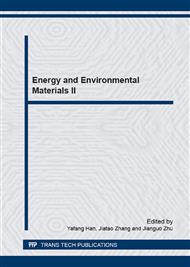[1]
K.S. Novoselov, A.K. Geim, S.V. Morozov, et al., Electric field effect in atomically thin carbon films, Science. 306(2004), 666-669.
DOI: 10.1126/science.1102896
Google Scholar
[2]
A . Geim, K.S. Novoselov, The rise of graphene, Nat. Mater. 6 (2007), 183-191.
Google Scholar
[3]
A.K. Geim, Graphene: Status and Prospect, Science. 324 (2009), 1530-1534.
Google Scholar
[4]
S. Park, R. S. Ruoff, Chemical methods for the production of graphenes, Nat. Nanotechnol. 4(2009), 217-224.
Google Scholar
[5]
H.C. Liang, X.Z. Li, Effects of structure of anodic TiO2 nanotube arrays on photocatalytic activity for the degradation of 2, 3-dichlorophenol in aqueous solution J. Hazard. Mater. 162(2009), 1415-1422.
DOI: 10.1016/j.jhazmat.2008.06.033
Google Scholar
[6]
L.M. Wang, N. Wang, L.H. Zhu, H.W. Yu, H.Q. Tang, Photocatalytic reduction of Cr(VI) over different TiO2 photocatalysts and the effects of dissolved organic species, J. Hazard. Mater. 52 (2008) 93-99.
DOI: 10.1016/j.jhazmat.2007.06.063
Google Scholar
[7]
Z.Q. Gao, S.G. Yang, C. Sun, J. Hong, Microwave assisted photocatalytic degradation of pentachlorophenol in aqueous TiO2 nanotubes suspension, Sep. Purif. Technol. 58 (2007), 24-31.
DOI: 10.1016/j.seppur.2006.12.020
Google Scholar
[8]
L.X. Yang, Y. Xiao, S.H. Liu et al., Photocatalytic reduction of Cr(VI) on WO3 doped long TiO2 nanotube arrays in the presence of citric acid, Appl. Catal. B: Environ. 94 (2010), 142-149.
DOI: 10.1016/j.apcatb.2009.11.002
Google Scholar
[9]
R. Asahi, T. Morikawa, T. Ohwaki et al., Visible-light photocatalysis in nitrogen-doped titanium oxides, Science. 293(2001), 269-271.
DOI: 10.1126/science.1061051
Google Scholar
[10]
S. Sakthivel, H. Kisch: Angew. Chem., Int. Ed. Vol. 42(2003), 4908-4911.
Google Scholar
[11]
J.G. Highfield, P. New:J. Chem. Vol. 13(1989), 61-69.
Google Scholar
[12]
S. Sakthivel, M. V. Shankar, B. Arabindoo et al., Enhancement of photocatalytic activity by metal deposition: Characterisation and photonic efficiency of Pt, Au and Pd deposited on TiO2 catalyst. Water Res. 38(2004), 3001-3008.
DOI: 10.1016/j.watres.2004.04.046
Google Scholar
[13]
V.H. Nguyen, J.J. Shim, Ionic liquid mediated synthesis of graphene-TiO2 hybrid and its photocatalytic activity, Mater. Sci. Eng.B. 180(2014), P. 38-45.
DOI: 10.1016/j.mseb.2013.10.011
Google Scholar
[14]
C.Y. Hu, F. Chen, T.W. Lu et al., Aqueous production of TiO2-graphene nanocomposites by a combination of electrostatic attraction and hydrothermal process, Mater. Let. . 121 (2014), 209-211.
DOI: 10.1016/j.matlet.2014.01.132
Google Scholar


